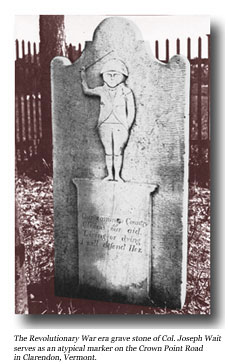History
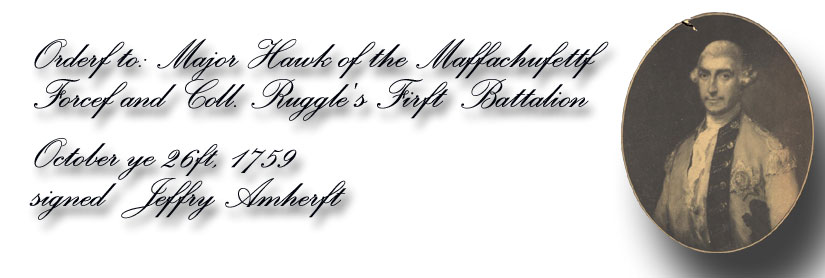 "Whereas nothing contributes more to the wealth and prosperity of a country than free and open communications to and from it on all sides and that by our present possession of Ticonderoga and Crown Point, a direct road from hence into New England by No. 4 must prove of the greatest advantages to the inhabitants and settlers of the latter particularly those of the Provinces of Massachusetts Bay and New Hampshire; I have accordingly for the mutual benefit of the whole, as well as that of the garrisons of Crown Point and Ticonderoga, caused a road to be marked and cutt from hence to No. 4, and in order that the same may be come known to and frequented by the people of New England, as well as to save their troops a long and tedious march, I have resolved to send these last home by this new road, and that they may meet with less fatigue and difficulties than are common to new roads in an uncultivated country, I propose to have the same entirely cleared, straightened and widened, and as I am convinced that no one is more equal to the task than yourself and that from your love for your Country and zeal for the common cause you will exert yourself to the utmost to carry this good design into execution in the best manner possible I do hereby repose that trust and confidence in you.
"Whereas nothing contributes more to the wealth and prosperity of a country than free and open communications to and from it on all sides and that by our present possession of Ticonderoga and Crown Point, a direct road from hence into New England by No. 4 must prove of the greatest advantages to the inhabitants and settlers of the latter particularly those of the Provinces of Massachusetts Bay and New Hampshire; I have accordingly for the mutual benefit of the whole, as well as that of the garrisons of Crown Point and Ticonderoga, caused a road to be marked and cutt from hence to No. 4, and in order that the same may be come known to and frequented by the people of New England, as well as to save their troops a long and tedious march, I have resolved to send these last home by this new road, and that they may meet with less fatigue and difficulties than are common to new roads in an uncultivated country, I propose to have the same entirely cleared, straightened and widened, and as I am convinced that no one is more equal to the task than yourself and that from your love for your Country and zeal for the common cause you will exert yourself to the utmost to carry this good design into execution in the best manner possible I do hereby repose that trust and confidence in you.
You will accordingly take upon you the command of the party appointed for that purpose by last night's orders, and with them proceed to the entrance of the said new road from hence which you will carry out in the most direct line possible to No. 4 clearing the forest all the way you go and widening it in every part to at least twenty feet and wherever it may be necessary to lay any bridges across you will lay them sufficiently strong to bear carriages.
You will also at every fifteen miles distance cause log'd fences to be put up for harboring and keeping together the cattle that will be drove through that road for the use of the troops.
And that nothing may retard you in this so necessary and essential work or that your party may not be so bothered they are to leave their arms behind them and I send you Lieut. Small of the Royal Highland Regiment with a party of thirty armed men of the Regulars not only to guard and serve you but to be aiding and assisting to you in everything that you shall require of him for the good of the frontier.
When your work is quite completed and finished in the manner before mentioned you may then dismiss your party at No. 4 where Lieut. Small will order them provisions sufficient to carry them to the inhabited country or farther if the men chuse it but if from thence they had rather have four pences in lieu of provisions they shall receive the same from him for so many days as at a moderate march will take the Massachusetts [men] to go to Worcester, the Connecticut to Hartford and the Rhode Islanders, Providence."
Signed Jeffry Amherst
" More than Two Hundred Fifty years ago, in 1759, the British government surveyed, constructed, and paid for Vermont's first interstate highway "
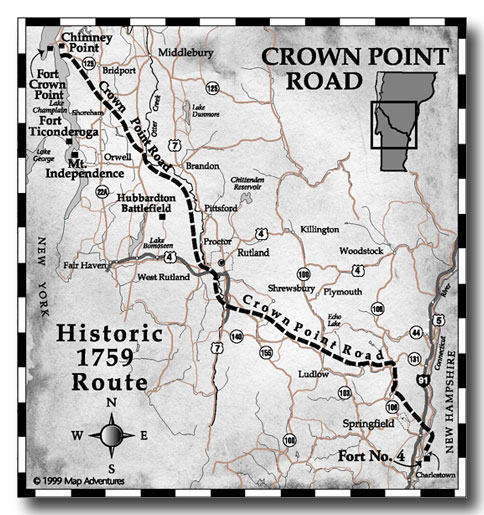
Named The Crown Point Road, it was built during the French and Indian War following England's defeat of French forces at Forts Carrilon and St. Frederic on Lake Champlain. Commanding General Jeffrey Amherst, wishing to continue the campaign into Canada, was in desperate need of fresh troops and supplies. Because the established supply route from the Atlantic ports by way of Albany and Lake George was long and difficult, Amherst needed a more direct route.
For centuries past, Native Americans had followed the waterways leading from Canada to the coast. One of the most-traveled routes connected Lake Champlain and the Connecticut River following Otter Creek and the Black River. By a stroke of fortune this footpath led from Amherst’s strategic position at Crown Point, New York directly to an important military post, Fort No. 4 on the Connecticut River.
The General ordered his engineers to devise a plan to improve the route, and Captain John Stark, commanding Rogers Rangers, then cut and marked the road. The road construction was primitive but served its purpose for the remainder of the French and Indian War.
During the American Revolution, Colonial Militias, schooled by the British during the previous war, turned the tables on them and utilized the road to their own advantage, contributing to the ultimate British defeat.
With the arrival of peace, perhaps the greatest contribution of the Crown Point Road to Vermont history was as a conduit for the great influx of settlers coming to the (then) New Hampshire Grants to establish towns and homesteads.Today, it is possible to walk or drive a car on many remaining sections of this ancient road, unique in American history.
The Road Builders
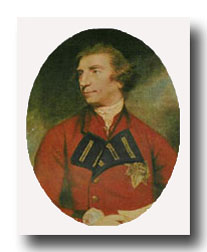 General Jeffrey Amherst (1717 - 1797)
General Jeffrey Amherst (1717 - 1797)
Jeffrey Amherst was born into privilege in England, and, as was the custom among his peers, chose a career in the British army. He was well-suited to the military life and rose quickly to positions of trust.
After serving with distinction in the European theatre he was assigned to conduct England's campaign to drive the French from the New World. His first accomplishment was in 1758 when he took the French stronghold at Louisburg on Cape Breton Island.
His next task was to take Quebec and Montreal. Sailing from Louisburg, he arrived in Boston and set off across Massachusetts to Albany. The trip was difficult with his troops mired down on rudimentary roads in the wilderness.
Once in Albany he established winter quarters and prepared for his march through the Champlain valley to Canada.The next year, 1759, he launched his attack, easily taking the French forts Carillon and Saint Frederic on Lake Champlain.
At about the same time, Quebec had fallen to General Wolfe and Amherst took the opportunity to rest at Crown Point on the site of Fort Saint Frederic which had been blown up by the retreating French. Here he ordered the construction of a massive fortress and the building of a small fleet.
Wishing to expedite the connection of his supply route to the Atlantic seaports, he ordered a road cut to the strategic outpost and rallying point at Fort No. 4 on the Conncticut River. And, looking into the future, he envisioned the road as an incentive for settlers who would establish England's foothold in New England.
Amherst was critized for his caution but it paid off in 1760 when he took Montreal and the French surrendered. He was rewarded with the title of Governor General of British North America and the acclaim of his countrymen.
The General believed in strict discipline and sobriety for his troops. While these harsh measures were accepted by the Regulars, they were anathema to the Colonials. They would remember the harsh treatment and the contempt they received from the British when they next met them during the American Revolution.
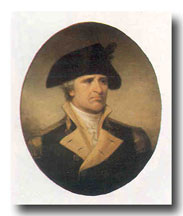 Captain John Stark (1728 - 1820)
Captain John Stark (1728 - 1820)
General John Stark, the epitome of a New Hampshireman, will be remembered in American History as the hero of the Battle of Bennington where his men routed the forces of Burgoyne and sent them demoralized to their defeat at Saratoga in 1777. However; this was just one of the many military accomplishments of this extraordinary man who fought for his country in both the French and Indian and Revolutionary Wars.
John Stark was born in 1728 in Londonderry, NH, the son of Scotch-Irish immigrants. As a young man he was a woodsman and hunter; and one hunting expedition changed his life when he was captured by Indians and taken to the village of St. Francis. Instead of succumbing to the indignities heaped upon him by the Indians, Stark resisted and became a favorite of the chiefs. By the time he was exchanged and returned home he had become well-schooled in, and sympathetic to, the ways of Native Americans.
When he became a captain in Rogers Rangers, this knowledge stood him in good stead in encounters with the French and their Indian allies. He served in the defense of Fort William Henry and took part in the 1758 attack on Ticonderoga. In 1759 he was at the surrender of Ticonderoga and Crown Point. During his time at Crown Point he was ordered to cut and mark a road from the great stone fortress to Fort No. 4 on the Connecticut River. This was to be an important supply route for troops and provisions needed for the invasion of Canada. At the same time, Rogers was leading the raid on the St Francis Indians and it is possible Stark may have felt satisfied not to take part in that infamous incident.
At the end of the war Stark returned home to resume farming and operating his sawmill. When he heard the news of the battles at Lexington and Concord, he immediately gathered his fellow New Hampshiremen, forming the First New Hampshire Regiment of which he would be colonel.
The first test of the regiment would be at Bunker Hill where they performed with gallantry. Afterward they were ordered to New York and then to Canada. At Ticonderoga they heard the reading of the Declaration of Independence.
Show More
In December they were ordered to Delaware to reinforce General Washington and took part in the battle of Trenton. When Stark returned to New Hampshire he received a demoralizing blow from his superiors. He had expected a promotion but was passed over for men he considered inferior and so resigned his commission.
However; he once again heard the call to duty with the news of Burgoyne's invasion of the Champlain Valley and accepted command of the New Hampshire militia. In characteristic fashion he defied orders to go to Albany and instead proceeded to Bennington where the situation seemed to him to be more urgent. Of course he proved himself correct and rescued the invaluable stores at Bennington.
This may have been the high point of his career but in his old age his fondest memories were of his days as a frontier scout. He died at age 92 and was the last surviving general officer of the Continental Army.
Show Less
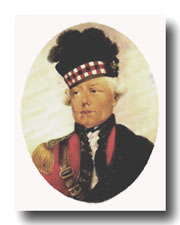 Lieutenant John Small (1726 - 1796)
Lieutenant John Small (1726 - 1796)
John Small was born at Strathardle in Athole, Scotland in 1726. After serving in the Scottish brigade in the Dutch service, he obtained a commission as ensign in the 42nd (Royal Highland) Regiment of Foot in 1747. This famed Scottish infantry regiment in the British Army became known as the Black Watch due to the dark color of the government issue tartan they were required to wear. On the eve of the departure of his regiment to America in 1756 he was appointed lieutenant.
During the French and Indian War, Lt. John Small took part under Major General Abercrombie in the first battle of Ticonderoga, also known as the Battle of Carillon (1758). Although his regiment lost over half of its men in the assault Lt. Small survived. Thereafter in 1759, Small accompanied Sir Jeffrey Amherst in his expedition against Canada and it was during this period that Lt. Small became directly involved with the construction and improvement of the Crown Point Road.
Major General Jeffrey Amherst seized control of Fort St. Frederic on Lake Champlain, known by the British as Crown Point, in August 1759. Shortly thereafter, Amherst ordered the construction of a road across what is now Vermont to Fort No. 4 on the Connecticut River in order to facilitate the movement of troops and supplies, and to improve communications between British forces stationed along the frontier. A force of 200 Rangers under the command of Captain John Stark departed from the Fortress at Crown Point in August of 1759 and returned to Crown Point in September of that year after roughing out the road.Many details regarding the construction of the Crown Point Road are documented in letter reports from Lt. John Small to Gen. Jeffrey Amherst. Through this correspondence it has become evident that Lt. Small was a strong advocate for improvement of the road and that, beyond his assigned duties, he became involved in a personal crusade to improve the Crown Point Road.
To read more on the life of Lieutenant John Small please visit our featured biography at the link below:
Origins of the Crown Point Road Markers
By Martin J. Howe
In the latter part of the last century [1800's] several markers were placed by individuals to mark the route of the road. These supplemented the original milestones set by the builders of the road. Only two of these crude markers [No.s 18 and 22], both in Weathersfield, now remain.
The Daughters of the American Revolution performed a valuable service in the period 1909-1914 when they were instrumental in placing a number of granite markers in many towns along the route of the Crown Point Road. At about the same time, additional markers of the same size and material were erected by several of the towns along the road. These markers were placed on traveled highways at points where the highways intersected the Crown Point Road or at points as near as possible to the Crown Point Road. On many of these markers an arrow engraved on top indicates the general direction of the Crown Point Road. These arrows are not reliable in all cases as several of the markers have been moved from their original positions because of road construction. In later years the Crown Point Road Association has erected numerous markers along the old route. The markers are maintained by CPRA members with assistance from adjoining landowners and veterans organizations.
